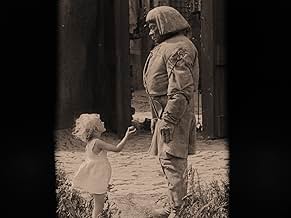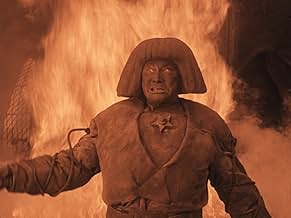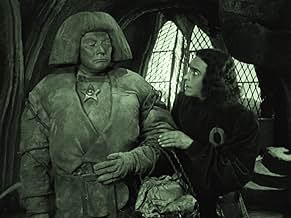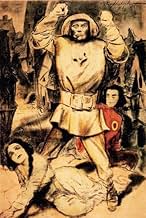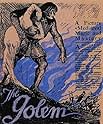NOTE IMDb
7,2/10
9,1 k
MA NOTE
Au 16e siècle, à Prague, un rabbin crée le Golem, une créature géante faite d'argile. Grâce à la sorcellerie, il donne vie à la créature afin de protéger les Juifs de Prague des persécutions... Tout lireAu 16e siècle, à Prague, un rabbin crée le Golem, une créature géante faite d'argile. Grâce à la sorcellerie, il donne vie à la créature afin de protéger les Juifs de Prague des persécutions.Au 16e siècle, à Prague, un rabbin crée le Golem, une créature géante faite d'argile. Grâce à la sorcellerie, il donne vie à la créature afin de protéger les Juifs de Prague des persécutions.
- Réalisation
- Scénario
- Casting principal
- Récompenses
- 1 victoire et 1 nomination au total
Hans Stürm
- Der Rabbi Jehuda, der Älteste der Gemeinde
- (as Hans Sturm)
Carl Ebert
- Temple Servant
- (non crédité)
Fritz Feld
- Jester
- (non crédité)
Loni Nest
- Ein kleines Mädchen
- (non crédité)
- …
Ursula Nest
- Little Girl
- (non crédité)
Dore Paetzold
- Des Kaisers Kebse
- (non crédité)
- …
Märte Rassow
- Kind
- (non crédité)
Avis à la une
This is, currently, the only silent movie I have ever seen, and I was unsure how I'd take it. I had heard a lot about this movie and was expecting big things, and I must say I was impressed.
The only major complain I have is that, as with many older classics, I read a review of it prior to buying in which the reviewer gave WAY too much away (the ending sequence, namely).. this has happened to me far too many times. I really wish reviewers wouldn't assume that everyone has already seen the movies they are reviewing, just because they are 'classics'. It really dampened my experience with the ending of both this movie, and The Man with X-Ray Eyes, just to name a few.
Anywho, the version I saw (the Kino remaster) was great. The picture quality was about as good as you could expect from a film more than 80 years old. The score was very good, maybe a tad repetitive, but it suit the film. The acting is quite good, very reminiscant of the acting style from the mid-to-early 20th century.
The scare factor? Well, probably not much these days. The Jewish ghetto is very well constructed, and really suits the setting. The golem himself is not so scary, more goofy to me, but to people in 1920, I can imagine he could have been quite scary. This is more of an 'interest' movie, than an all-out scare fest. You can really see where so many of the great horror/scare films over the years got their ideas from after seeing early films such as this.
I would definately recommend everyone who is interested in horror to track it down. Don't be put off by the fact that it's a silent film, it took all of 20 seconds for me to forget that completely, and to just enjoy the film.
The only major complain I have is that, as with many older classics, I read a review of it prior to buying in which the reviewer gave WAY too much away (the ending sequence, namely).. this has happened to me far too many times. I really wish reviewers wouldn't assume that everyone has already seen the movies they are reviewing, just because they are 'classics'. It really dampened my experience with the ending of both this movie, and The Man with X-Ray Eyes, just to name a few.
Anywho, the version I saw (the Kino remaster) was great. The picture quality was about as good as you could expect from a film more than 80 years old. The score was very good, maybe a tad repetitive, but it suit the film. The acting is quite good, very reminiscant of the acting style from the mid-to-early 20th century.
The scare factor? Well, probably not much these days. The Jewish ghetto is very well constructed, and really suits the setting. The golem himself is not so scary, more goofy to me, but to people in 1920, I can imagine he could have been quite scary. This is more of an 'interest' movie, than an all-out scare fest. You can really see where so many of the great horror/scare films over the years got their ideas from after seeing early films such as this.
I would definately recommend everyone who is interested in horror to track it down. Don't be put off by the fact that it's a silent film, it took all of 20 seconds for me to forget that completely, and to just enjoy the film.
This landmark film is one of the earliest surviving expressionist works, and it's art direction and photography-- while not as stunning as a film like Caligari-- is still extremely interesting with its misshapen sets and its use of light and shadow, and light within shadow. Unlike Caligari, the themes of this film were resonant long after its release, and perhaps still are today.
The Golem is a tolerance film that studies in depth the relationship between Jews and Christians in Prague. To his credit, Wegener refuses to impose stereotypes on either party, instead concentrating on individual characters and using mass characterizations only to highlight the themes of the film.
Unlike stereotypical Jews, rich guys with big noses who rub pennies together, the Jews of Prague are decidedly poor. It is interesting to note that the Jews are all dressed in black and with very few exceptions appear to be bent with age, a tribute to an aging and dying religion. However, they are also portrayed to be earnest and hard-working, with strong communal instincts. The Christians, by contrast, appear bright, shiny, and new. They are dressed in light colors and are young and wealthy, and outwardly appear to be God's new chosen. However, they are also portrayed as foolish bohemians who do not take God seriously. In the end, Christian innocents (and blonde-blue Aryan, coincidentally)are able to stop the Golem's rampage, but only because he allows it. The final shot shows the Star of David lying in the dust as the Jews come to carry their fallen champion back into the ghetto, closing the great door behind them and leaving you with a feeling that they are gone forever. However, it should be noted that the Golem is not only a champion to the Jews, but a symbol of revival.
Another interesting comparison in this film is that between the Golem and Jesus. Like man, the Golem is made of sand and clay, then given life by a supernatural force. They are both immaculate conceptions, with the Golem being motherless while Jesus is born to a virgin mother. Jesus in his time was a champion of the Jews, as is the Golem, and each of them rebelled against the wickedness of the authorities that governed them.
This open-ended presentation of the struggle of Christianity vs. Judaism is what makes this film truly great. I suspect that this relevant elevation above the ordinary is the reason for its survival, even though it is the third film of this series. The fact that Wegener was able to make a film that is so ambiguous is a credit to him considering the circumstances surrounding German film-making at the time.
Rabbi Loew is portrayed as a wise and heroic leader of the Jewish community, which lives in a winding ghetto. He creates the Golem for a noble cause-- to protect his people against eviction by the Christians--and in this cause succeeds after the Christian court is saved by the Golem from divine repudiation after laughing at Loew's presentation of the Old Testament. The creation scene is particularly interesting, not only in its visuals, but for the fact that in this scene Rabbi Loew wears white (for purity), yet performs a ceremony that is holy in nature yet seems like witchcraft. The Golem turns on him when he seeks to continue using the Golem's services for selfish purposes after the Golem has accomplished his mission.
Miriam and Loew's servant are portrayed quite differently. Miriam is a dark seductress who is unwittingly the cause of the Golem's destructive rampage. She is only saved from the hands of the Golem by another act of divine intervention, when the communal prayer of the Jews in the streets of the ghetto results in her release. She usually dresses in dark colors. However, there is also a scene before her affair with Florian in which she wears white (purity of a different kind). Also notice how Florian carelessly twirls a flower when he delivers the edict to Rabbi Loew. This is a brief, but effective, example of his character and foreshadows things to come. Loew's servant is the only other young Jewish character in the film besides a few Jewish children in the street, and it is his revival of the Golem during his jealous rage against Florian that sets the Golem on his destructive path. Like Loew, he is unable to remove the Star of David from the Golem's chest once he begins to use the Golem for selfish gain. In the end, he shares a poignant moment with Miriam where they seek forgiveness and confidence about their actions.
The depth and attention to detail that Wegener shows as a director (and writer) in this film helps to place it among the great films in the brief history of cinema. It's message is particularly haunting considering the events of the next 25 years after its release.
The Golem is a tolerance film that studies in depth the relationship between Jews and Christians in Prague. To his credit, Wegener refuses to impose stereotypes on either party, instead concentrating on individual characters and using mass characterizations only to highlight the themes of the film.
Unlike stereotypical Jews, rich guys with big noses who rub pennies together, the Jews of Prague are decidedly poor. It is interesting to note that the Jews are all dressed in black and with very few exceptions appear to be bent with age, a tribute to an aging and dying religion. However, they are also portrayed to be earnest and hard-working, with strong communal instincts. The Christians, by contrast, appear bright, shiny, and new. They are dressed in light colors and are young and wealthy, and outwardly appear to be God's new chosen. However, they are also portrayed as foolish bohemians who do not take God seriously. In the end, Christian innocents (and blonde-blue Aryan, coincidentally)are able to stop the Golem's rampage, but only because he allows it. The final shot shows the Star of David lying in the dust as the Jews come to carry their fallen champion back into the ghetto, closing the great door behind them and leaving you with a feeling that they are gone forever. However, it should be noted that the Golem is not only a champion to the Jews, but a symbol of revival.
Another interesting comparison in this film is that between the Golem and Jesus. Like man, the Golem is made of sand and clay, then given life by a supernatural force. They are both immaculate conceptions, with the Golem being motherless while Jesus is born to a virgin mother. Jesus in his time was a champion of the Jews, as is the Golem, and each of them rebelled against the wickedness of the authorities that governed them.
This open-ended presentation of the struggle of Christianity vs. Judaism is what makes this film truly great. I suspect that this relevant elevation above the ordinary is the reason for its survival, even though it is the third film of this series. The fact that Wegener was able to make a film that is so ambiguous is a credit to him considering the circumstances surrounding German film-making at the time.
Rabbi Loew is portrayed as a wise and heroic leader of the Jewish community, which lives in a winding ghetto. He creates the Golem for a noble cause-- to protect his people against eviction by the Christians--and in this cause succeeds after the Christian court is saved by the Golem from divine repudiation after laughing at Loew's presentation of the Old Testament. The creation scene is particularly interesting, not only in its visuals, but for the fact that in this scene Rabbi Loew wears white (for purity), yet performs a ceremony that is holy in nature yet seems like witchcraft. The Golem turns on him when he seeks to continue using the Golem's services for selfish purposes after the Golem has accomplished his mission.
Miriam and Loew's servant are portrayed quite differently. Miriam is a dark seductress who is unwittingly the cause of the Golem's destructive rampage. She is only saved from the hands of the Golem by another act of divine intervention, when the communal prayer of the Jews in the streets of the ghetto results in her release. She usually dresses in dark colors. However, there is also a scene before her affair with Florian in which she wears white (purity of a different kind). Also notice how Florian carelessly twirls a flower when he delivers the edict to Rabbi Loew. This is a brief, but effective, example of his character and foreshadows things to come. Loew's servant is the only other young Jewish character in the film besides a few Jewish children in the street, and it is his revival of the Golem during his jealous rage against Florian that sets the Golem on his destructive path. Like Loew, he is unable to remove the Star of David from the Golem's chest once he begins to use the Golem for selfish gain. In the end, he shares a poignant moment with Miriam where they seek forgiveness and confidence about their actions.
The depth and attention to detail that Wegener shows as a director (and writer) in this film helps to place it among the great films in the brief history of cinema. It's message is particularly haunting considering the events of the next 25 years after its release.
At the beginning of the DvD's "scrapbook", there is a quote from Paul Wegener that says he never thought the Golem was an expressionist film. Watching it right after seeing Nosferatu, that statement becomes believable. Despite amazing sets that would have been at home in Caligari, in story, in acting, and in overall tone, The Golem is a much more naturalistic film. Watching it with my son, who is 16, he was struck by its uncomfortable prefiguring of Jewish persecution. I was impressed by the the scarcity of romantic cliches in the story. The golem itself is clearly the ancestor of the Frankenstein monster. Full of wonderful images and interesting as a predecessor of the Universal monster films, The Golem is also very entertaining as a story and as a piece of dramatic film making. Highly recommended.
When I see these old attempts at what amounted to a horror film back then, before my time and I'm an old duffer, I'm always struck at the marvelous Gothic quality wrought by the twisted buildings, the gnarled stairways, the open balconies and the weird angles of things such as doorways, arches, street, bridges and the like. The monstrosities are stark, hardly terrifying by today's CGIs and often terrifying their victims in an almost comical, stylized way. This marvelous film together with Nosferatu and The Cabinet of Dr. Caligari are marvelous pieces of art. There is an ageless quality to them that transcends the hoary and often corny plots and acting. Each must be taken as a whole because that product is always greater than the sum of their parts. Compare the magical Indian Love Call of Nelson Eddy and Jeanette MacDonald, two rather mainstream singers whose voices blend into something greater than either of their individual talents. So too it is, I contend, with these old Gothic classics. Horror? Hardly. But, their starkness and darkness with its twisted surroundings are still eerie and provoking.
Although this 1920 German silent does not really rank alongside the truly great silent films, it remains a fascinating oddity. Based on European Jewish folklore, it tells the story a Jewish community in Prague which is threatened with expulsion from the city. In an effort to protect his people, Rabbi Loew creates a man-like creature made of clay and uses it to impress the Emperor. Unfortunately, the magic backfires, and when the Golem falls into the hands of the Rabbi's perfidious assistant disaster results.
Much of the film's charm is in its visual style. The sets by Hans Poelzig are a strange but cohesive mixture of medieval, nouveau, and surrealism, and the cinematography by legendary photography Karl Freund uses high contrast black and white to truly remarkable effect. The Poelzig-Freund combination would cast an extremely long shadow, and THE GOLEM would influence not only such German films as Fitz Lang's METROPOLIS but the entire cycle of 1930s American horror films that began with the 1931 Bela Lugosi Dracula.
Several plot devices and the look of the Golem, as played by Paul Wegener, would also prove particularly influential for director James Whale's famous 1932 FRANKENSTEIN. Whether or not Boris Karloff or make-up artist Jack Pierce knew the film is uncertain--but Whale, who was fond of German cinema, certainly did, and traces of THE GOLEM can be seen throughout his most famous works.
Over the past several decades a number of film historians have attempted to reinterpret THE GOLEM in light of the Holocaust. There may actually be a certain validity to this, for although the Jews are portrayed sympathetically they are very clearly outsiders, and their religion seems less like religion than witchcraft--and indeed Rabbi Loew might be said to practice black magic in bringing the Golem to life. This sense of social estrangement and religious stigmatism does seem indicative of the anti-Semitism that will ultimately explode into furnaces of Nazi Germany. All the same, it is worth noting that THE GOLEM is a fundamentally Jewish story to begin with, and it is perhaps best to think of it in those terms instead of using hindsight to impose modern meanings upon the film.
There are several home market releases of the film. While I have not seen it, I am told the Timeless Studios VHS release is weak; I have, however, seen the Gotham DVD release, and although there are some quality issues this inexpensive DVD is not at all bad. Still, my preference and recommendation is the Kino DVD. Unlike many Kino editions, it does not have anything significant in the way of bonuses, but the overall presentation is very fine and likely represents a best-possible presentation short of full digital restoration.
Much of the film's charm is in its visual style. The sets by Hans Poelzig are a strange but cohesive mixture of medieval, nouveau, and surrealism, and the cinematography by legendary photography Karl Freund uses high contrast black and white to truly remarkable effect. The Poelzig-Freund combination would cast an extremely long shadow, and THE GOLEM would influence not only such German films as Fitz Lang's METROPOLIS but the entire cycle of 1930s American horror films that began with the 1931 Bela Lugosi Dracula.
Several plot devices and the look of the Golem, as played by Paul Wegener, would also prove particularly influential for director James Whale's famous 1932 FRANKENSTEIN. Whether or not Boris Karloff or make-up artist Jack Pierce knew the film is uncertain--but Whale, who was fond of German cinema, certainly did, and traces of THE GOLEM can be seen throughout his most famous works.
Over the past several decades a number of film historians have attempted to reinterpret THE GOLEM in light of the Holocaust. There may actually be a certain validity to this, for although the Jews are portrayed sympathetically they are very clearly outsiders, and their religion seems less like religion than witchcraft--and indeed Rabbi Loew might be said to practice black magic in bringing the Golem to life. This sense of social estrangement and religious stigmatism does seem indicative of the anti-Semitism that will ultimately explode into furnaces of Nazi Germany. All the same, it is worth noting that THE GOLEM is a fundamentally Jewish story to begin with, and it is perhaps best to think of it in those terms instead of using hindsight to impose modern meanings upon the film.
There are several home market releases of the film. While I have not seen it, I am told the Timeless Studios VHS release is weak; I have, however, seen the Gotham DVD release, and although there are some quality issues this inexpensive DVD is not at all bad. Still, my preference and recommendation is the Kino DVD. Unlike many Kino editions, it does not have anything significant in the way of bonuses, but the overall presentation is very fine and likely represents a best-possible presentation short of full digital restoration.
Le saviez-vous
- Anecdotes"Aemaet", the life-giving word which Rabbi Lowe compels from the spirit Astaroth is also reflected in the bolts of lightning at the end of the creation scene.
- GaffesThe story is set in the 16th Century. A prediction of doom is made based on the movements of Uranus, which was not discovered until 1781.
- Versions alternativesThe 2002 Alpha Video DVD version runs for 101 minutes. This is not evident from the back of the Alpha Video DVD case, which wrongly lists the running time as only 85 minutes. It looks as if Alpha Video somehow got hold of the fullest version currently known - maybe even a complete version of the film, since there are no obvious gaps in the story.
- ConnexionsEdited into People Who Die Mysteriously in Their Sleep (2004)
Meilleurs choix
Connectez-vous pour évaluer et suivre la liste de favoris afin de recevoir des recommandations personnalisées
- How long is The Golem?Alimenté par Alexa
Détails
- Durée1 heure 16 minutes
- Couleur
- Mixage
- Rapport de forme
- 1.33 : 1
Contribuer à cette page
Suggérer une modification ou ajouter du contenu manquant



